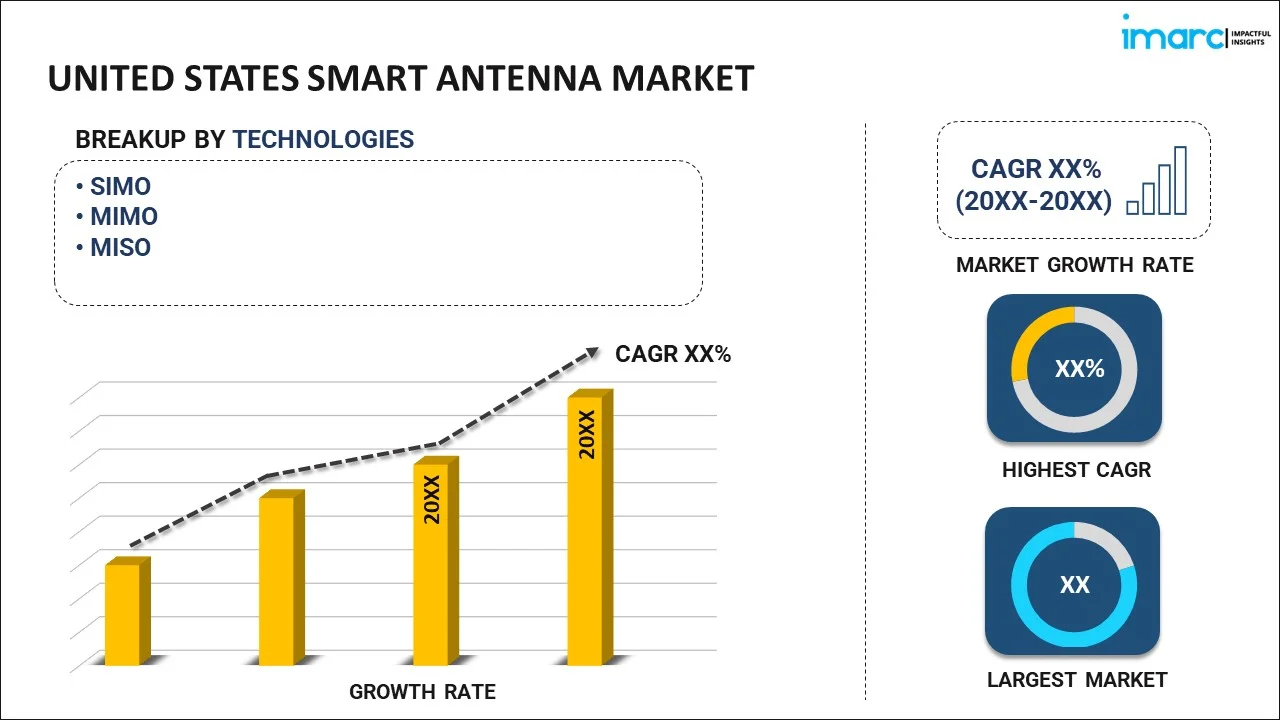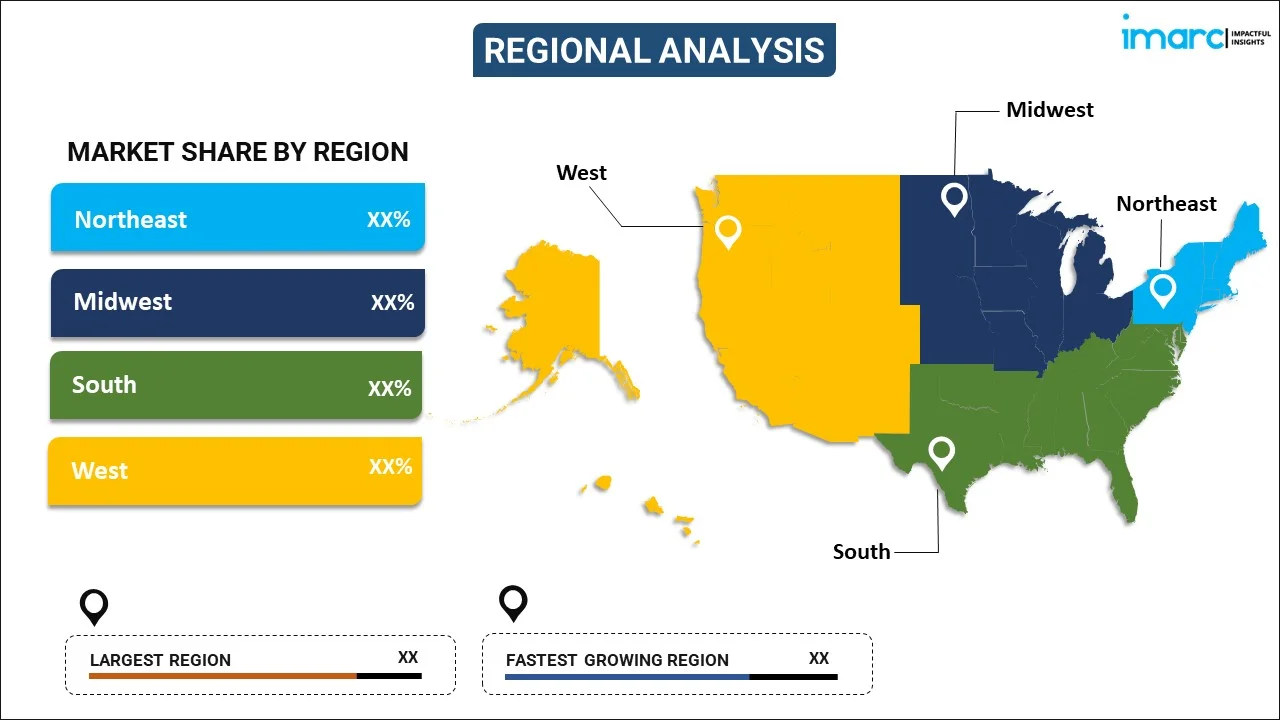
United States Smart Antenna Market Report by Technology (SIMO, MIMO, MISO), Application (Wi-Fi Systems, WiMAX Systems, Cellular Systems, RADAR System), and Region 2025-2033
Market Overview:
United States smart antenna market size is projected to exhibit a growth rate (CAGR) of 9.60% during 2025-2033. The development of vehicle safety communication measures and the inflating need for faster data processing are primarily propelling the market growth across the country.
|
Report Attribute
|
Key Statistics
|
|---|---|
|
Base Year
|
2024 |
|
Forecast Years
|
2025-2033
|
|
Historical Years
|
2019-2024
|
| Market Growth Rate (2025-2033) | 9.60% |
A smart antenna refers to a device that has the capability to modify its beam pattern based on the desired criteria, offering numerous advantages, such as enhanced capacity, spectral efficiency, extended coverage and range, etc. Its purpose is to both transmit and receive multiple radio frequency (RF) waves, leading to heightened data speed and a reduction in error rates. By incorporating smart signal processing algorithms, it also facilitates wireless communications, connecting signals from multiple receivers and managing the transmission and reception of signals, as well as capacity and coverage in mobile wireless networks. Consequently, a smart antenna is extensively utilized in various industries, including telecommunications, information technology (IT), automotive, defense, etc., across the United States.
United States Smart Antenna Market Trends:
The United States smart antenna market is experiencing substantial growth driven by contemporary drivers and emerging trends. One of the key factors is the escalating demand for enhanced wireless communication capabilities. Additionally, with the proliferation of 5G networks and the increasing need for higher data speeds, smart antennas play a pivotal role in optimizing signal quality, reducing interference, bolstering overall network performance, etc. Besides this, the rising usage of artificial intelligence (AI) and machine learning is acting as another significant growth-inducing factor. Moreover, smart antennas are evolving to leverage advanced algorithms for adaptive beamforming, enabling more efficient signal transmission and reception. This trend is particularly crucial in urban environments where signal congestion and interference are common challenges. Furthermore, as the number of connected devices continues to surge in the United States, smart antennas facilitate seamless communication, ensuring efficient connectivity and data exchange in smart homes, smart cities, and various IoT applications. Apart from this, the widespread adoption of connected and autonomous vehicles is bolstering the market growth across the country. As such, the elevating popularity of cellular networking is anticipated to fuel the United States smart antenna market over the forecasted period.
United States Smart Antenna Market Segmentation:
IMARC Group provides an analysis of the key trends in each segment of the market, along with forecasts at the country level for 2025-2033. Our report has categorized the market based on technology and application.
Technology Insights:

- SIMO
- MIMO
- MISO
The report has provided a detailed breakup and analysis of the market based on the technology. This includes SIMO, MIMO, and MISO.
Application Insights:
- Wi-Fi Systems
- WiMAX Systems
- Cellular Systems
- RADAR Systems
A detailed breakup and analysis of the market based on the application have also been provided in the report. This includes Wi-Fi systems, WiMAX systems, cellular systems, and RADAR systems.
Regional Insights:

- Northeast
- Midwest
- South
- West
The report has also provided a comprehensive analysis of all the major regional markets, which include Northeast, Midwest, South, and West.
Competitive Landscape:
The market research report has also provided a comprehensive analysis of the competitive landscape in the market. Competitive analysis such as market structure, key player positioning, top winning strategies, competitive dashboard, and company evaluation quadrant has been covered in the report. Also, detailed profiles of all major companies have been provided.
United States Smart Antenna Market Report Coverage:
| Report Features | Details |
|---|---|
| Base Year of the Analysis | 2024 |
| Historical Period | 2019-2024 |
| Forecast Period | 2025-2033 |
| Units | Million USD |
| Scope of the Report | Exploration of Historical Trends and Market Outlook, Industry Catalysts and Challenges, Segment-Wise Historical and Future Market Assessment:
|
| Technologies Covered | SIMO, MIMO, MISO |
| Applications Covered | Wi-Fi Systems, WiMAX Systems, Cellular Systems, RADAR Systems |
| Regions Covered | Northeast, Midwest, South, West |
| Customization Scope | 10% Free Customization |
| Post-Sale Analyst Support | 10-12 Weeks |
| Delivery Format | PDF and Excel through Email (We can also provide the editable version of the report in PPT/Word format on special request) |
Key Questions Answered in This Report:
- How has the United States smart antenna market performed so far and how will it perform in the coming years?
- What has been the impact of COVID-19 on the United States smart antenna market?
- What is the breakup of the United States smart antenna market on the basis of technology?
- What is the breakup of the United States smart antenna market on the basis of application?
- What are the various stages in the value chain of the United States smart antenna market?
- What are the key driving factors and challenges in the United States smart antenna?
- What is the structure of the United States smart antenna market and who are the key players?
- What is the degree of competition in the United States smart antenna market?
Key Benefits for Stakeholders:
- IMARC’s industry report offers a comprehensive quantitative analysis of various market segments, historical and current market trends, market forecasts, and dynamics of the United States smart antenna market from 2019-2033.
- The research report provides the latest information on the market drivers, challenges, and opportunities in the United States smart antenna market.
- Porter's five forces analysis assist stakeholders in assessing the impact of new entrants, competitive rivalry, supplier power, buyer power, and the threat of substitution. It helps stakeholders to analyze the level of competition within the United States smart antenna industry and its attractiveness.
- Competitive landscape allows stakeholders to understand their competitive environment and provides an insight into the current positions of key players in the market.
Need more help?
- Speak to our experienced analysts for insights on the current market scenarios.
- Include additional segments and countries to customize the report as per your requirement.
- Gain an unparalleled competitive advantage in your domain by understanding how to utilize the report and positively impacting your operations and revenue.
- For further assistance, please connect with our analysts.
 Inquire Before Buying
Inquire Before Buying
 Speak to an Analyst
Speak to an Analyst
 Request Brochure
Request Brochure
 Request Customization
Request Customization




.webp)




.webp)












